Standards Worldwide
Standards Worldwide
Phone +49 30 58885700-07

Standard [CURRENT]
ASTM D 1586/D 1586M:2018
Standard Test Method for Standard Penetration Test (SPT) and Split-Barrel Sampling of Soils
- German title
- Eindringprüfung an Boden und Probenahme mit Kernrohr
- Publication date
- 2018
- Original language
- English
- Pages
- 26
- Publication date
- 2018
- Original language
- English
- Pages
- 26
- DOI
- https://dx.doi.org/10.1520/D1586_D1586M-18E01
Product information on this site:
Quick delivery via download or delivery service
Buy securely with a credit card or pay upon receipt of invoice
All transactions are encrypted
Short description
1.1 This test method describes the procedure, generally known as the Standard Penetration Test (SPT), for driving a split-barrel sampler with a 140 lb [63.5 kg] hammer dropped 30 in. [750 mm] to obtain a soil sample for identification purposes, and measure the resistance of the soil to penetration of the standard 2 in. [50 mm] diameter sampler. The SPT " N " value is the number of hammer blows required to drive the sampler over the depth interval of 0.5 to 1.5 ft [0.15 to 0.45 m] of a 1.5 ft [0.45 m] drive interval. 1.2 Test Method D4633 is generally necessary to measure the drill rod energy of a given drop hammer system and using the measured drill rod energy, N values can be corrected to a standard energy level. Practice D6066 uses Test Methods D1586 and D4633 and has additional requirements for hammers, hammer energy, and drilling methods to determine energy corrected penetration resistance of loose sands for liquefaction evaluation. 1.3 Practice D3550/D3550M is a similar procedure using a larger diameter split barrel sampler driven with a hammer system that may allow for a different hammer mass. The penetration resistance values from Practice D3550/D3550M do not comply with this standard. 1.4 Test results and identification information are used in subsurface exploration for a wide range of applications such as geotechnical, geologic, geoenvironmental, or geohydrological explorations. When detailed lithology is required for geohydrological investigations, use of continuous sampling methods ( D6282/D6282M , D6151/D6151M , D6914/D6914M ) are recommended when the incremental SPT N value is not needed for design purposes (see 4.1.1 ). 1.5 Penetration resistance testing is typically performed at 5 ft [1.5 m] depth intervals or when a significant change of materials is observed during drilling, unless otherwise specified. 1.6 This test method is limited to use in nonlithified soils and soils whose maximum particle size is approximately less than one-half of the sampler diameter. 1.7 This test method involves use of rotary drilling equipment (Guide D5783 , Practice D6151/D6151M ). Other drilling and sampling procedures (Guides D6286 and D6169/D6169M ) are available and may be more appropriate. Considerations for hand driving or shallow sampling without boreholes are not addressed. Subsurface investigations should be recorded in accordance with Practice D5434 . Samples should be preserved and transported in accordance with Practice D4220/D4220M using Group B. Soil samples should be identified by group name and symbol in accordance with Practice D2488 . 1.8 All observed and calculated values shall conform to the guidelines for significant digits and rounding established in Practice D6026 , unless superseded by this test method. 1.8.1 The procedures used to specify how data are collected/recorded and calculated in the standard are regarded as the industry standard. In addition, they are representative of the significant digits that generally should be retained. The procedures used do not consider material variation, purpose for obtaining the data, special purpose studies, or any considerations for the user's objectives; and it is common practice to increase or reduce significant digits of reported data to be commensurate with these considerations. It is beyond the scope of these test methods to consider significant digits used in analysis methods for engineering data. 1.9 Units- The values stated in either inch-pound or SI units [presented in brackets] are to be regarded separately as standard. The values stated in each system may not be exact equivalents; therefore, each system shall be used independently of the other. Combining values from the two systems may result in non-conformance with the standard. Reporting of test results in units other than inch-pound shall not be regarded as nonconformance with this practice. SI equivalent units shown herein are in general conformance with existing international standards. 1.10 Penetration resistance measurements often will involve safety planning, administration, and documentation. This test method does not purport to address all aspects of exploration and site safety. 1.11 Performance of the test usually involves use of a drill rig; therefore, safety requirements as outlined in applicable safety standards (for example, OSHA regulations, 2 NDA Drilling Safety Guide, 3 drilling safety manuals, and other applicable local agency regulations) must be observed. 1.12 This standard does not purport to address all of the safety concerns, if any, associated with its use. It is the responsibility of the user of this standard to establish appropriate safety, health, and environmental practices and determine the applicability of regulatory limitations prior to use. 1.13 This international standard was developed in accordance with internationally recognized principles on standardization established in the Decision on Principles for the Development of International Standards, Guides and Recommendations issued by the World Trade Organization Technical Barriers to Trade (TBT) Committee.
ICS
93.020
DOI
https://dx.doi.org/10.1520/D1586_D1586M-18E01
Also available in
Loading recommended items...
Loading recommended items...
Loading recommended items...
Loading recommended items...
